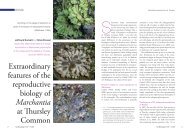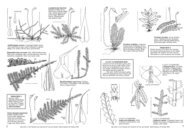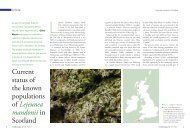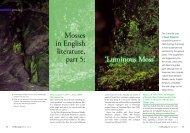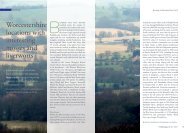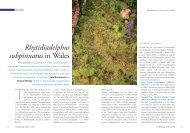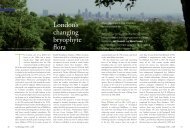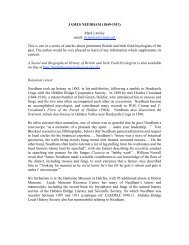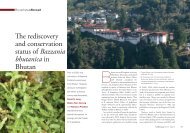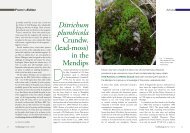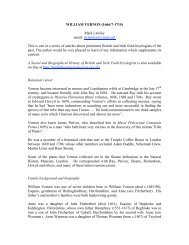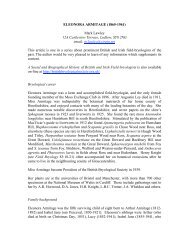William Wilson (1799–1871) - Royal Botanic Garden Edinburgh
William Wilson (1799–1871) - Royal Botanic Garden Edinburgh
William Wilson (1799–1871) - Royal Botanic Garden Edinburgh
You also want an ePaper? Increase the reach of your titles
YUMPU automatically turns print PDFs into web optimized ePapers that Google loves.
This is one in a series of articles about prominent British and Irish field<br />
bryologists of the past. The author, Mark Lawley, would be very pleased to learn<br />
of any information which supplements its content. A more general but at present<br />
unfinished Social and Biographical History of British and Irish Field-bryologists<br />
is available online at www.britishbryologicalsociety.org.uk<br />
<strong>William</strong> <strong>Wilson</strong> was Britain’s<br />
leading bryologist in the mid-<br />
19th century. Like most bryologists<br />
of that period, he paid<br />
more attention to mosses<br />
than liverworts, and discovered 60 or more<br />
mosses new to Britain, Ireland or science. For<br />
example, Dicranella schreberiana, Ephemerum<br />
sessile, Fissidens polyphyllus, Homomallium incurvatum,<br />
Orthodontium gracile, Paludella squarrosa,<br />
Philonotis cernua (Bartramidula wilsonii), Philonotis<br />
marchica and Physcomitrium sphaericum<br />
were new to the British or Irish bryoflora, with<br />
Plagiothecium latebricola, Scleropodium cespitans<br />
and Tortula wilsonii new to science. He also<br />
discovered mountain bladder fern (Cystopteris<br />
montana) on Ben Lawers and was the first botanist<br />
to distinguish the two filmy ferns (Hymenophyllum<br />
tunbrigense and H. wilsonii), which he<br />
found growing together in Killarney in 1829.<br />
In 1846 he agreed to produce a third edition<br />
of W.J. Hooker and Thomas Taylor’s Muscologia<br />
BygoneBryologists<br />
<strong>William</strong> <strong>Wilson</strong> (<strong>1799–1871</strong>)<br />
Britannica, and his revision assumed a sufficiently<br />
new identity to be published under his own name<br />
as Bryologia Britannica in 1855. <strong>Wilson</strong> planned<br />
but did not live to complete a second edition,<br />
which would have included an additional 100<br />
species discovered in Britain between 1855 and<br />
1870.<br />
Many of <strong>Wilson</strong>’s plants, drawings and letters<br />
are at the Natural History Museum in London.<br />
Bolton Museum and Art Gallery also has some of<br />
his bryophytes. Other papers lie in the archives<br />
at New York <strong>Botanic</strong> <strong>Garden</strong>, the National<br />
Library of Wales at Aberystwyth, Warrington<br />
Library, the <strong>Royal</strong> <strong>Botanic</strong> <strong>Garden</strong> at Kew, the<br />
Botany Department at Manchester Museum,<br />
and Liverpool Museum.<br />
Family background<br />
Such a common surname as <strong>Wilson</strong> makes<br />
it frustratingly difficult to establish a reliable<br />
pedigree for <strong>William</strong> <strong>Wilson</strong> and his relatives.<br />
The water is further muddied (and the blood<br />
FieldBryology No96 | Oct08 39
Bygone Bryologists – <strong>William</strong> <strong>Wilson</strong> Bygone Bryologists – <strong>William</strong> <strong>Wilson</strong><br />
thickened) by his marriage to a cousin who was<br />
born a <strong>Wilson</strong>. Moreover, the Christian names of<br />
Hamlet, <strong>William</strong>, Mary, and probably also Eliza<br />
and Isabel, were popular in the family, cropping<br />
up in branches of the <strong>Wilson</strong> clan (or clans)<br />
at Congleton, Manchester and Warrington,<br />
and making it still more difficult to be sure of<br />
individual identities and family connections.<br />
Nevertheless, <strong>William</strong> <strong>Wilson</strong> the botanist was<br />
certainly the second-born son of Thomas <strong>Wilson</strong><br />
(ca 1760–1820), a druggist of Warrington,<br />
Lancashire (now in Cheshire) and Mary (née<br />
Allen, ca 1772–1855). Thomas doubtless had to<br />
know his plants in order to prepare medicines<br />
for dispensing, and may have taken his young<br />
son with him when he searched for plants in the<br />
countryside around Warrington.<br />
Thomas was successful in business, for in 1820<br />
he left £1,000 to his married daughter Ann,<br />
before leaving the residue of his estate (including<br />
numerous properties) to his widow Mary and<br />
two surviving sons <strong>William</strong> and Hamlet.<br />
Thomas <strong>Wilson</strong> was probably a son of Hamlet<br />
<strong>Wilson</strong>, husbandman and farmer of Warrington,<br />
while his wife Mary was a daughter of John<br />
Allen (died 1812), a cotton-manufacturer of<br />
Warrington. Thus, <strong>William</strong> had family connections<br />
with the textile trade, an industry with<br />
a remarkable number of botanists in its ranks<br />
during the 18th and 19th centuries (see A Social<br />
and Biographical History of British and Irish<br />
Field-bryologists at www.britishbryologicalsociety.<br />
org.uk) (Lawley, 2008).<br />
Like Thomas, Mary was a native of Warrington,<br />
and they married there in August 1791. In the<br />
following year they had their first child, Ann,<br />
who married John Sherratt of Congleton in<br />
1808.<br />
Thomas and Mary’s second child was Thomas<br />
(born in 1794). He probably died young, for he<br />
is not mentioned in his father’s will of 1820.<br />
n <strong>William</strong> <strong>Wilson</strong>. Hunt Institute for <strong>Botanic</strong>al<br />
Documentation, Carnegie Mellon University, Pittsburgh,<br />
PA, USA<br />
Next was <strong>William</strong>, born on 7 June 1799,<br />
followed by a third son, Hamlet (1802–1874)<br />
who became interested in entomology. Hamlet<br />
married Mary <strong>William</strong>s of Llansantffraid,<br />
Denbighshire, in 1838 and they had a daughter<br />
Mary (born 1840/41) and a son <strong>William</strong> Hamlet<br />
(1841/2–1883). By 1861, and in 1871, Hamlet<br />
<strong>Wilson</strong> was living at Plastirion, Llansantffraid,<br />
off rents and interest from properties he owned.<br />
His son <strong>William</strong> Hamlet <strong>Wilson</strong> became a<br />
chemist with a general dealer’s shop at Brynderwen,<br />
Dwygyfylchi, near Penmaenmawr,<br />
Caernarvonshire.<br />
<strong>William</strong> <strong>Wilson</strong>’s family may possibly also<br />
have been connected by blood with the Pattens<br />
and <strong>Wilson</strong>-Pattens of Warrington. Perhaps the<br />
middle name of <strong>William</strong>’s eldest son, John Leigh<br />
<strong>Wilson</strong>, signifies descent from the Leigh (or Ley)<br />
family of Cheshire, which had been prominent<br />
in the county for several centuries. Mary Leigh<br />
(ca 1642–1720), daughter of John Leigh of<br />
Oughtrington, by Lymm, near Warrington,<br />
married Thomas Patten (1638–ca 1684) in<br />
Warrington. Their daughter Mary Patten (1674–<br />
1704) married Thomas <strong>Wilson</strong> (1663–1755) at<br />
Newchurch, Lancashire, in 1698. This Thomas<br />
<strong>Wilson</strong> was bishop of Sodor and Man. In 1779,<br />
a John Leigh of Oughtrington went into business<br />
with Thomas Patten in order to refine sugar in<br />
Warrington.<br />
In 1697, a Thomas Patten who owned a coppersmelting<br />
works at Bank Quay in Warrington had<br />
caused the River Mersey to be made navigable to<br />
Bank Quay. The Lancastrian Pattens descended<br />
from a family of the same name in Lincolnshire<br />
and Essex. <strong>William</strong> Patten (or Waynflete, ca<br />
1400–1486) of Dagenham, Essex, was bishop of<br />
Winchester, Lord High Chancellor of England in<br />
1456, and founded Magdalene College, Oxford.<br />
In a later generation, John <strong>Wilson</strong>-Patten,<br />
Baron Winmarleigh (1802–1892) achieved<br />
sufficient prominence as a politician (particularly<br />
in connection with reforming industrial relations<br />
and factory law) to merit inclusion in the<br />
Dictionary of National Biography. He was born<br />
John <strong>Wilson</strong>, a second son of Thomas <strong>Wilson</strong><br />
(né Patten, ca 1770–1827) of Bank Hall (now<br />
the Town Hall), Warrington, who had changed<br />
his name in order to inherit estates from the<br />
Thomas <strong>Wilson</strong> (1663–1755) who was bishop<br />
of Sodor and Man. These <strong>Wilson</strong>s changed their<br />
surname again to <strong>Wilson</strong>-Patten in 1823.<br />
<strong>William</strong> <strong>Wilson</strong>’s descent from these Leighs and<br />
Pattens of Cheshire and Lancashire must remain<br />
speculative until further genealogical research<br />
proves or disproves consanguinity; it is equally<br />
possible that John Leigh <strong>Wilson</strong> acquired his<br />
middle name from one of his father’s respected<br />
colleagues or friends. Fortunately, however, much<br />
archival material remains to be examined (including<br />
<strong>William</strong> <strong>Wilson</strong>’s correspondence), so there<br />
is every likelihood that more will be discovered<br />
about <strong>William</strong>’s close and distant relatives.<br />
Biography<br />
<strong>William</strong> <strong>Wilson</strong> was educated first at a dame<br />
school kept by a Mrs Du Garney, a former actress<br />
who had married a French refugee. Later he<br />
attended the grammar school at Prestbury, and<br />
finally the Dissenters’ Academy in Leaf Square,<br />
Manchester.<br />
<strong>William</strong>’s family were devout Congregationalists,<br />
as was John Rylands (1771–1848), a wiremanufacturer<br />
of Warrington. John Rylands and<br />
a <strong>William</strong> <strong>Wilson</strong> were sometime trustees of<br />
Warrington Congregationalists’ Chapel, which<br />
had been founded in 1776. John Rylands’ son,<br />
Thomas Glazebrook Rylands (1818–1900), took<br />
much interest in natural sciences, including<br />
botany, and became co-executor for the estate of<br />
Mary <strong>Wilson</strong> after she died in 1855, and also for<br />
<strong>William</strong>’s in 1871.<br />
From the Dissenters’ Academy, <strong>William</strong> was<br />
articled to Messrs Barratt and <strong>Wilson</strong>, solicitors<br />
of Manchester. Was this partner <strong>Wilson</strong> a relative<br />
of <strong>William</strong>’s? His cousin and future wife was born<br />
Eliza <strong>Wilson</strong> in Manchester, probably to Hamlet<br />
<strong>Wilson</strong> and Mary [née Lee (Leigh?)]. Perhaps<br />
Eliza’s father Hamlet was of the same branch of<br />
the family that practised law in Manchester. Later<br />
in her life, Eliza’s widowed mother, Mary (died<br />
1861), lived in Congleton, Cheshire, and finally<br />
in the Warrington district. Some of <strong>William</strong>’s im-<br />
mediate antecedents may also have practised law<br />
in Warrington, for Thomas, <strong>William</strong>’s father, was<br />
‘of Sankey Street, Warrington’ when he died in 1820,<br />
and Pigot’s Directory for 1828/9 lists <strong>Wilson</strong> and<br />
Bradford as attorneys practising in Sankey Street.<br />
A career in law did not suit <strong>William</strong>, though,<br />
and as he came of a comfortably placed middle-<br />
40 FieldBryology No96 | Oct08 FieldBryology No96 | Oct08 41
Bygone Bryologists – <strong>William</strong> <strong>Wilson</strong> Bygone Bryologists – <strong>William</strong> <strong>Wilson</strong><br />
n Two species discovered in Britain by <strong>William</strong> <strong>Wilson</strong>: Dicranella schreberiana (left) and Scleropodium cespitans (right).<br />
Des Callaghan (left) & Ian Atherton (right)<br />
class background, he was able to forsake the<br />
profession a few years after his father died. By the<br />
mid-1820s, botany occupied much of <strong>William</strong>’s<br />
time, and he was corresponding with Sir James<br />
Edward Smith, Professor John Stevens Henslow<br />
at Cambridge, and <strong>William</strong> Jackson Hooker at<br />
Glasgow. In 1827 Hooker invited him to join<br />
his field class for undergraduate students in the<br />
Breadalbane hills of Perthshire, and after the<br />
week’s botanizing <strong>Wilson</strong> stayed on at the village<br />
of Killin until mid-September.<br />
He was back at Killin in late June 1829, at the<br />
start of a 9-month tour that also encompassed<br />
Wales and Ireland. <strong>Wilson</strong> sailed from Glasgow<br />
for Dublin on 15 July, from where he went to<br />
Cork and found Cyclodictyon laetevirens, and<br />
subsequently at Killarney. He also found Philonotis<br />
cernua (Bartramidula wilsonii) and one of<br />
the Sematophyllum species in south-west Ireland<br />
at this time, as well as new sites for the rare<br />
Daltonia splachnoides. At the expense of vascular<br />
plants, mosses monopolized his attention from<br />
this time on.<br />
Back in north-west England, <strong>Wilson</strong> often<br />
botanized around Over, near Delamere Forest,<br />
where relatives lived. There he found Tortula<br />
wilsonii new to science in 1831, as well as Plagiothecium<br />
latebricola, and Helodium blandowii,<br />
Paludella squarrosa and Physcomitrium sphaericum<br />
near Knutsford, and in January 1832 he<br />
found Scleropodium cespitans near his home in<br />
Warrington, recognizing it as new to science.<br />
The following year, he found Orthodontium<br />
gracile at Helsby, Cheshire. And 30 years later,<br />
in 1863, <strong>Wilson</strong> described Philonotis caespitosa<br />
near Warrington.<br />
<strong>Wilson</strong> kept journals of his tours in Scotland<br />
and Ireland (1827–1829) and for the years<br />
1832–1835; these were donated to Warrington<br />
Library after he died. He also corresponded with<br />
leading European bryologists such as Lindberg<br />
and Schimper, as well as working-class botanists<br />
like Edward Hobson, John Martin and John<br />
Nowell. <strong>Wilson</strong>’s entry in the Dictionary of<br />
National Biography states that he was extremely<br />
neat, fastidious, and highly strung, and these<br />
characteristics caused him to sustain and preserve<br />
a voluminous correspondence. He took interest<br />
in the temperance movement, and corresponded<br />
with the temperance preacher Frederick Richard<br />
Lees, who was father of the botanist Frederick<br />
Arnold Lees (1847–1921).<br />
In 1836, <strong>Wilson</strong> spent several weeks with<br />
Joseph Dalton Hooker (W.J. Hooker’s son) in<br />
the Aberdeenshire hills and on Ben Lomond,<br />
but thereafter marriage and the responsibilities<br />
of family life curtailed his opportunities for<br />
travel.<br />
<strong>Wilson</strong> married his widowed cousin, Eliza<br />
Lane (née <strong>Wilson</strong>, 1802–1871) at St Pancras,<br />
London, in 1836 or 1837. Eliza had previously<br />
married <strong>William</strong> Lane (died 1832), and their<br />
daughter Eliza Ann was christened in Manchester<br />
in November 1826. At the time of the 1851<br />
Census Return, Eliza Ann was visiting the family<br />
of the physician and amateur bryologist John<br />
Bland Wood (1813–1890), whose wife Eliza-<br />
beth had been born in Manchester. John and<br />
Elizabeth’s second child was named <strong>William</strong><br />
<strong>Wilson</strong> Wood, so perhaps Eliza Ann was related<br />
to Elizabeth Wood. Before her marriage to<br />
John Bland Wood, Elizabeth’s surname had<br />
been Jackson. Eliza Ann Lane married the artist<br />
Robert Collinson (1832–1890) in 1855; she<br />
died in 1872.<br />
By the late 1830s <strong>William</strong> and Eliza had set<br />
up home in Manchester Lane, Warrington. In<br />
1839 they were living at Bruck (Brick?) Cottage,<br />
and in 1841 their address was ‘Twiggery’,<br />
Manchester Road. They are also said to have<br />
lived for some years at Orford Mount, which<br />
was presumably near Orford Hall, for long the<br />
Blackburne family’s residence, of whom Anna<br />
Blackburne (1726–1793) was an accomplished<br />
botanist and correspondent of Linnaeus and<br />
other naturalists.<br />
<strong>William</strong> and Eliza’s first child was John Leigh<br />
<strong>Wilson</strong>. The Census Return of 1841 gives his<br />
age as three and a half, putting his birth in or<br />
about December 1837, whereas he was said to be<br />
50 when he died in January 1886. He married<br />
Edith Maria Challis at Kensington in 1868, but<br />
Edith died in 1871, aged 29. John married again<br />
in 1873, to Lucy <strong>Wilson</strong>, daughter of Thomas<br />
<strong>Wilson</strong>, silk mercer of Frodsham, Cheshire, but<br />
the marriage failed, and they lived apart from the<br />
mid-1870s. In 1871 (presumably after his first<br />
wife died) John was ‘of Paddington’, and he was<br />
living at Padgate, Warrington in 1873. At the<br />
time of his death he was living in Bewsey Street,<br />
Warrington. He was a civil engineer, and had<br />
been connected with the Civil Service in Madras,<br />
India.<br />
<strong>William</strong> and Eliza’s second child, Isabel, was<br />
born in November 1839, followed by <strong>William</strong><br />
Hooker <strong>Wilson</strong> (born August 1841, died<br />
December 1841) and Ada Mary (1843–1859).<br />
At the time of the 1851 Census Return, John<br />
and the two girls were living with their parents in<br />
Manchester Road. <strong>William</strong> and Eliza moved into<br />
Paddington House (a large residence which is<br />
now a hotel) after <strong>William</strong>’s mother died in 1855.<br />
Isabel was listed as an ‘artistic scholar’ in the<br />
1861 Census. She remained single and lived with<br />
her parents until they died in 1871. <strong>William</strong> died<br />
just before the 1871 Census, leaving an estate<br />
valued at less than £10,000, and was buried in<br />
the non-conformist burial ground at High Cliff,<br />
near Warrington. Eliza followed him to the grave<br />
in December of that year. Soon after, in June<br />
1872, Isabel married Josiah Pemberton <strong>William</strong>s<br />
(ca 1817–1887). In 1886 they were living at<br />
Sleaforth, near Liverpool.<br />
This somewhat tedious account of <strong>William</strong><br />
<strong>Wilson</strong>’s family background and circumstances<br />
is justified by the paucity of details which have<br />
previously been published about him. Apparently<br />
insignificant facts and clues may encourage<br />
others to follow up and contribute to what is<br />
known about this seminal figure in the history<br />
of British bryology, who merits a full-scale<br />
biography. Many family connections remain to<br />
be elucidated or confirmed, and perusal of his<br />
letters would surely also add much to what is<br />
known of his life and activities.<br />
Mark Lawley<br />
12A Castleview Terrace, Ludlow SY8 2NG<br />
(e m.lawley@virgin.net)<br />
Reference<br />
Lawley, M. (2008). The influence of social background on the<br />
emergence of British field botanists in the 17–19th centuries:<br />
<strong>William</strong> <strong>Wilson</strong>, a case study. Field Bryology 94, 28–35.<br />
42 FieldBryology No96 | Oct08 FieldBryology No96 | Oct08 43



